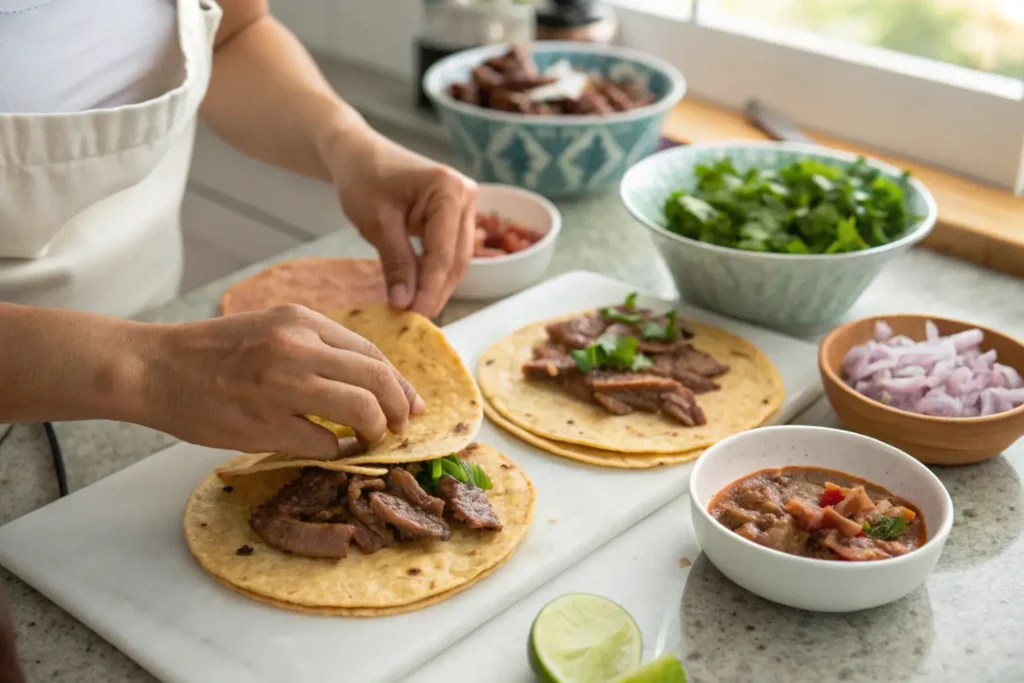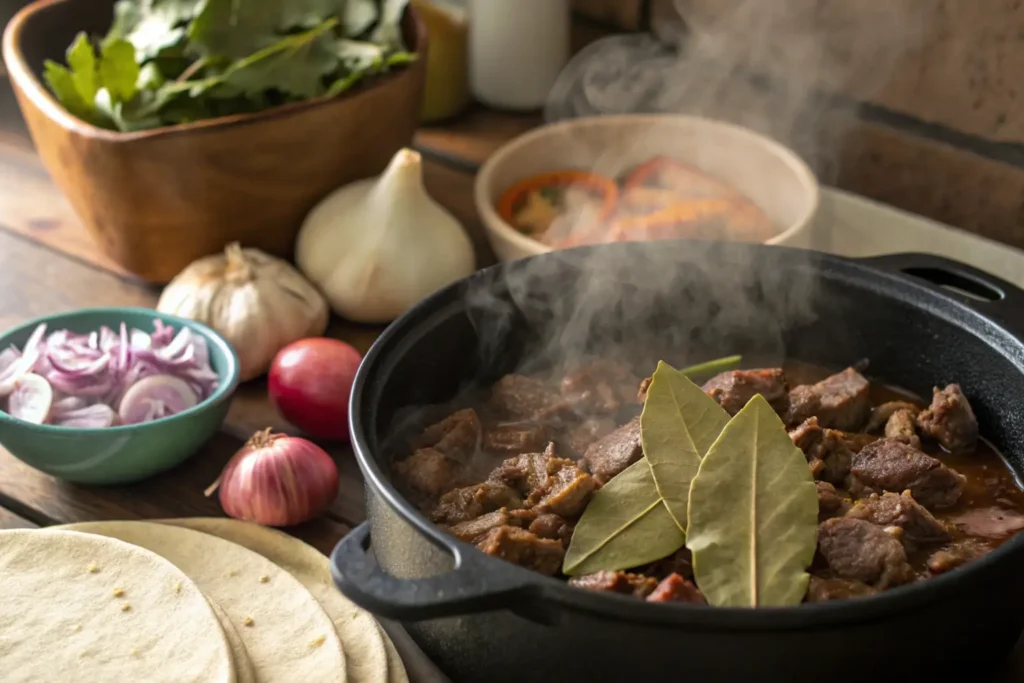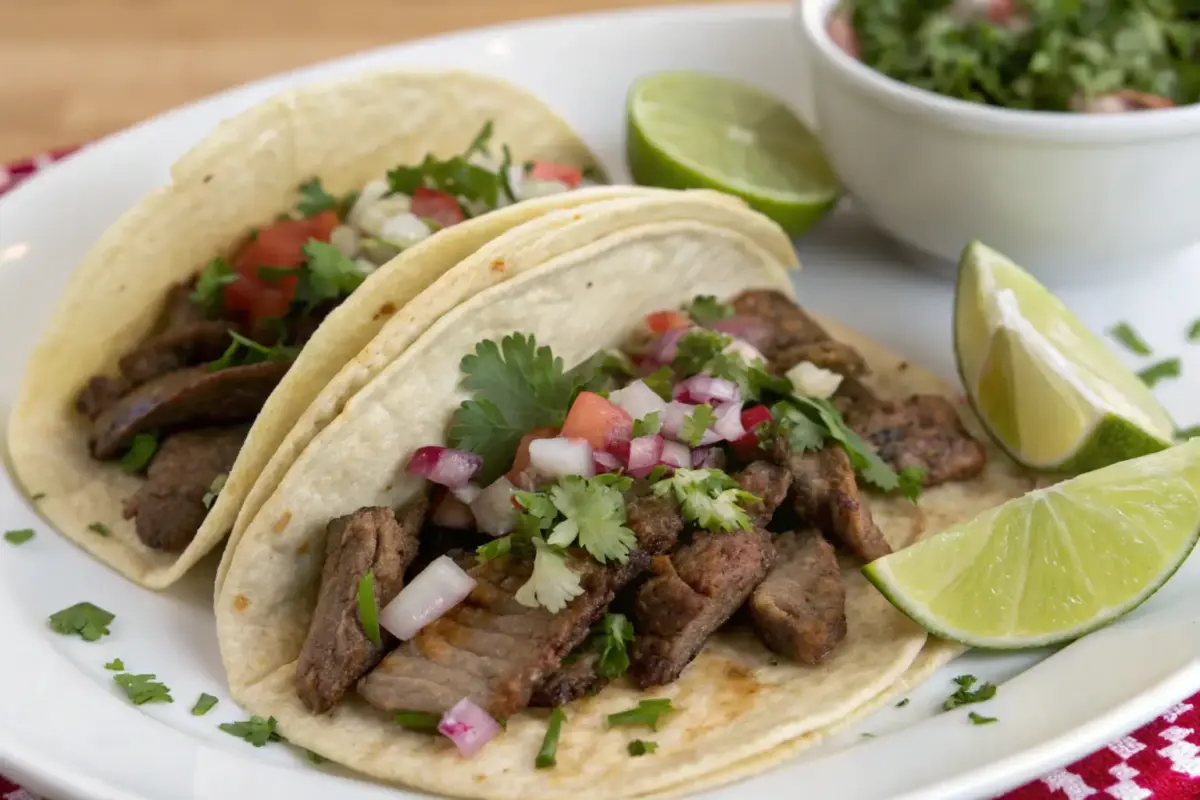Introduction
Tacos de Lengua, or beef tongue tacos, are a beloved staple of traditional Mexican cuisine. Known for their tender texture and bold, savory flavor, these tacos have been a favorite in Mexican households for generations. If you’ve never tried them, you’re in for a treat—though the idea of eating tongue might sound unusual, the result is surprisingly delicious. Trust me, this is one taco variety that’ll win you over with the first bite.
The Origin and History of Tacos de Lengua
Like many iconic Mexican dishes, Tacos de Lengua have a long and fascinating history. Beef tongue was originally a popular cut because of its affordability and rich taste. Families would slow-cook it to make the meat tender and infuse it with flavor. Over time, Tacos de Lengua found their way from rural kitchens to bustling city markets and street food stalls. Today, they’re a symbol of authentic Mexican cooking, celebrated across regions and even in international kitchens.
Why Tacos de Lengua Are a Must-Try Dish
Let’s face it—there’s nothing quite like biting into a perfectly prepared Taco de Lengua. The tender meat, seasoned to perfection, paired with fresh tortillas, zesty salsas, and toppings, creates a flavor explosion you won’t forget. Whether you’re a food adventurer or just someone who appreciates good eats, this dish checks all the boxes. It’s hearty, satisfying, and packed with the kind of flavor that keeps you coming back for more.
The Key Ingredients for Authentic Beef tongue tacos
Choosing the Perfect Beef Tongue
The star of the show here is, of course, the beef tongue. When shopping, look for a fresh, high-quality tongue with smooth, even skin. Don’t worry—it might look a little intimidating at first, but once it’s cooked and prepared, it transforms into a melt-in-your-mouth delight. Pro tip: If possible, buy it from a butcher or local meat market where you can get expert advice on selecting the best cut.
Essential Spices and Seasonings
Seasoning is where the magic happens. Tacos de Lengua typically feature simple yet flavorful ingredients like garlic, onions, bay leaves, salt, and black pepper. These are added during cooking to enhance the natural taste of the meat. Want to level it up? Some recipes include a touch of cumin or cloves for an extra aromatic kick.
Traditional Toppings and Accompaniments
No taco is complete without the right toppings! For Tacos de Lengua, traditional choices include diced onions, fresh cilantro, a squeeze of lime, and a drizzle of salsa verde or roja. Feeling adventurous? Add sliced radishes, avocado, or pickled jalapeños for a bit of crunch and tang. Don’t forget a warm corn tortilla to bring it all together—soft, slightly charred tortillas are the unsung heroes of this dish. Learn more about how to heat tortillas in the oven to achieve the perfect texture for your tacos.
The Cultural Significance of Tacos de Lengua in Mexican Cuisine
Regional Variations Across Mexico
Depending on where you go in Mexico, you’ll find Tacos de Lengua prepared in slightly different ways. In some regions, the tongue is grilled for a smoky flavor, while others keep it simple with a slow-cooking method that highlights its natural richness. These variations reflect the diversity of Mexican cuisine and its deep connection to local ingredients and cooking traditions.
Beef tongue tacos in Modern Culinary Trends
Tacos de Lengua are no longer just a traditional dish—they’re now a trendy item on menus around the world. Chefs are reimagining them with gourmet twists, incorporating fusion flavors, and serving them up at high-end restaurants. But despite all the innovation, the heart of the dish remains the same: it’s about honoring simple, humble ingredients and turning them into something extraordinary.
Tacos de Lengua are more than just a dish—they’re a part of Mexico’s rich culinary heritage. As street food and family traditions intertwine, desserts like churro cheesecake often follow, offering a sweet ending to a savory feast. These dishes together represent the diversity and warmth of Mexican cooking.
How to Prepare Tacos de Lengua at Home

Step-by-Step Cooking Instructions
Cleaning and Preparing the Beef Tongue
Okay, let’s start with the basics. Before cooking, the beef tongue needs to be thoroughly cleaned. Rinse it under cold water to remove any debris, and don’t be afraid to get in there with a knife to trim off any rough spots. Some people prefer to blanch it briefly in boiling water for easier handling—totally optional, but it works like a charm. Pat it dry and get ready to cook!
Slow-Cooking for Maximum Flavor
This is where the magic happens. Place the tongue in a large pot or slow cooker, add water to cover, and toss in aromatics like garlic, onion, bay leaves, salt, and pepper. Let it simmer gently for about 3–4 hours, or until the tongue is fork-tender. Trust me, the longer it cooks, the better it gets. Pro tip: Save that cooking liquid—it makes an amazing base for soups or stews.
Slicing and Serving Techniques
Once the tongue is cooked, let it cool slightly before handling. The outer skin should peel off easily—don’t skip this step, or you’ll end up with a chewy texture. Slice the tongue into thin strips or small chunks, depending on your preference. Now it’s ready to hit the tortillas!
Tips for Perfecting Your Beef tongue tacos

Want to take your Tacos de Lengua to the next level? Here are a few insider tips:
- Char your tortillas: Heat them over an open flame or in a dry skillet for that authentic smoky flavor.
- Double up on tortillas: Using two tortillas prevents tearing and makes your tacos sturdier.
- Customize your toppings: While traditional toppings are great, feel free to experiment with cheese, crema, or even a drizzle of hot honey for a unique twist.
Health Benefits of Tacos de Lengua
Nutritional Value of Beef Tongue
Don’t let the idea of eating tongue scare you—it’s packed with nutrients! Beef tongue is a great source of protein, iron, zinc, and vitamin B12, making it an excellent choice for building muscle and supporting overall health. Plus, it’s relatively low in fat compared to other cuts, so you can enjoy it guilt-free.
How Tacos de Lengua Fit into a Balanced Diet
When paired with fresh toppings and whole-grain corn tortillas, Tacos de Lengua can easily fit into a balanced meal. The protein keeps you full, while the veggies and herbs add a boost of vitamins and minerals. Even better? The slow-cooking method preserves the meat’s natural nutrients without adding unnecessary oils or fats.
Pairing Tacos de Lengua with Drinks and Sides
Traditional Mexican Beverages to Complement Your Meal
What’s a taco feast without the right drink? For a traditional vibe, serve your Tacos de Lengua with a refreshing agua fresca, like horchata or tamarindo. If you’re in the mood for something stronger, a crisp cerveza or a smooth margarita pairs beautifully with the rich flavors of the meat. Want something adventurous? Try a smoky mezcal—it’s a game-changer.
Side Dishes That Enhance the Experience
Tacos de Lengua are amazing on their own, but the right sides can elevate the whole meal. For dessert, why not try something sweet with a Mexican twist? Explore what Mexican cheesecake is made of for a creamy, rich finale to your meal.
Common Mistakes to Avoid When Making Tacos de Lengua
Overcooking or Undercooking the Beef Tongue
Timing is everything. Undercooked tongue is tough and unpleasant, while overcooked tongue can lose its flavor and become mushy. Stick to the recommended cooking time, and check for tenderness by inserting a fork into the thickest part—it should go in easily without resistance.
Using the Wrong Spices or Toppings
While it’s fun to get creative, sticking to traditional seasonings ensures the authentic flavor of Tacos de Lengua shines through. Avoid overpowering the meat with heavy sauces or too many toppings—this dish is all about balance. Keep it simple, and let the rich, tender beef tongue be the star of the show.
Where to Find the Best Tacos de Lengua
Top Restaurants in Mexico Serving Tacos de Lengua
If you’re lucky enough to visit Mexico, you’ll find Tacos de Lengua at countless local taquerías. Some top spots include Mexico City’s iconic El Huequito, known for their perfectly seasoned tongue, and Guadalajara’s street stalls, where the smoky aroma of freshly cooked tacos fills the air. These places are not just about the food—they’re about the experience of enjoying a beloved dish where it’s been perfected for decades.
How to Identify Authentic Tacos de Lengua Spots
Not all Tacos de Lengua are created equal, so how can you tell you’re getting the real deal? First, look for places where the tongue is cooked fresh daily. Authentic spots usually slow-cook the beef tongue until it’s tender, rather than rushing the process. Pay attention to the toppings, too—traditional tacos will feature fresh onions, cilantro, and handmade tortillas. And don’t be afraid to ask locals for recommendations. If there’s a long line at a stall, chances are it’s worth the wait!
Tacos de Lengua vs. Other Mexican Tacos
How They Compare to Tacos al Pastor and Tacos de Carnitas
When it comes to variety, Mexican tacos are like a treasure chest of flavors. Tacos al Pastor bring the sweetness of pineapple and a hint of spice, while Tacos de Carnitas offer crispy, caramelized pork. But Tacos de Lengua stand out for their rich, melt-in-your-mouth texture and bold, beefy flavor. They’re less about flashy seasonings and more about letting the quality of the meat shine. If you’re a fan of hearty, satisfying tacos, these will quickly become your go-to choice.
Unique Flavors and Textures of Beef tongue tacos
What makes Tacos de Lengua so special is their texture. The slow-cooked tongue becomes incredibly tender, almost creamy, with a flavor that’s rich but not overwhelming. Pair that with the zing of lime, the crunch of fresh onions, and the slight smokiness of a toasted tortilla, and you’ve got a taco that hits every note. It’s a completely different vibe from the crispiness of carnitas or the spice-forward flavor of al pastor.
How to Store and Reheat Beef tongue tacos
Best Practices for Preserving Freshness
Got leftovers? Lucky you! To keep Beef tongue tacos fresh, store the cooked meat separately from the toppings and tortillas. Place the tongue in an airtight container with a bit of the cooking liquid to keep it moist, and refrigerate it for up to three days. Tortillas can be wrapped in foil or a clean kitchen towel to preserve their softness. Trust me, taking these extra steps makes a huge difference when you’re reheating.
Reheating Without Losing Flavor
Reheating Tacos de Lengua can be tricky, but it’s totally doable. For the meat, warm it gently in a pan with a splash of water or broth to prevent it from drying out. Tortillas are best reheated on a hot skillet or directly over a gas flame for that just-cooked flavor. Avoid the microwave if you can—it can zap the flavor and texture. Take the time to do it right, and your leftovers will taste just as amazing as the day you made them.
FAQs About Tacos de Lengua
What does “tacos de lengua” mean?
“Tacos de Lengua” translates to “tongue tacos” in English. It’s a traditional Mexican dish made using beef tongue that’s been cooked until tender and served in soft tortillas with toppings like onions, cilantro, and salsa.
Is beef tongue in tacos de lengua tough or chewy?
Not at all! When prepared correctly, beef tongue becomes incredibly tender and soft. The slow-cooking process breaks down the muscle fibers, resulting in a melt-in-your-mouth texture that’s anything but tough.
Are tacos de lengua healthy?
Yes, Beef tongue tacos can be a healthy choice. Beef tongue is high in protein and contains important vitamins and minerals like B12 and zinc. To keep the meal balanced, pair your tacos with fresh toppings and avoid overloading on heavy sauces.
Where can I find authentic tacos de lengua?
Authentic Beef tongue tacos are commonly found at taquerías in Mexico and Mexican restaurants in the U.S. For the best experience, look for spots known for their traditional cooking methods and fresh ingredients. Street vendors are often a great place to start!
Conclusion
Recap of the Rich Flavors and Cultural Importance
Tacos de Lengua aren’t just food—they’re an experience. From their rich history in Mexican culture to their tender, flavorful meat, these tacos are a celebration of tradition and taste. Whether you’re enjoying them at a bustling market in Mexico or making them at home, they’re a dish that brings people together and showcases the art of simple, delicious cooking.
Encouragement to Try Making or Ordering Beef tongue tacos
If you’ve never tried Tacos de Lengua, now’s the time to change that. Whether you whip them up in your own kitchen or hunt down a taquería that serves them, you won’t regret stepping out of your comfort zone. Who knows—they might just become your new favorite taco. So grab a tortilla, pile on the toppings, and dig in. You’re in for a seriously satisfying meal.


1 thought on “Tacos de Lengua Made Easy: Recipes, Tips, and History”